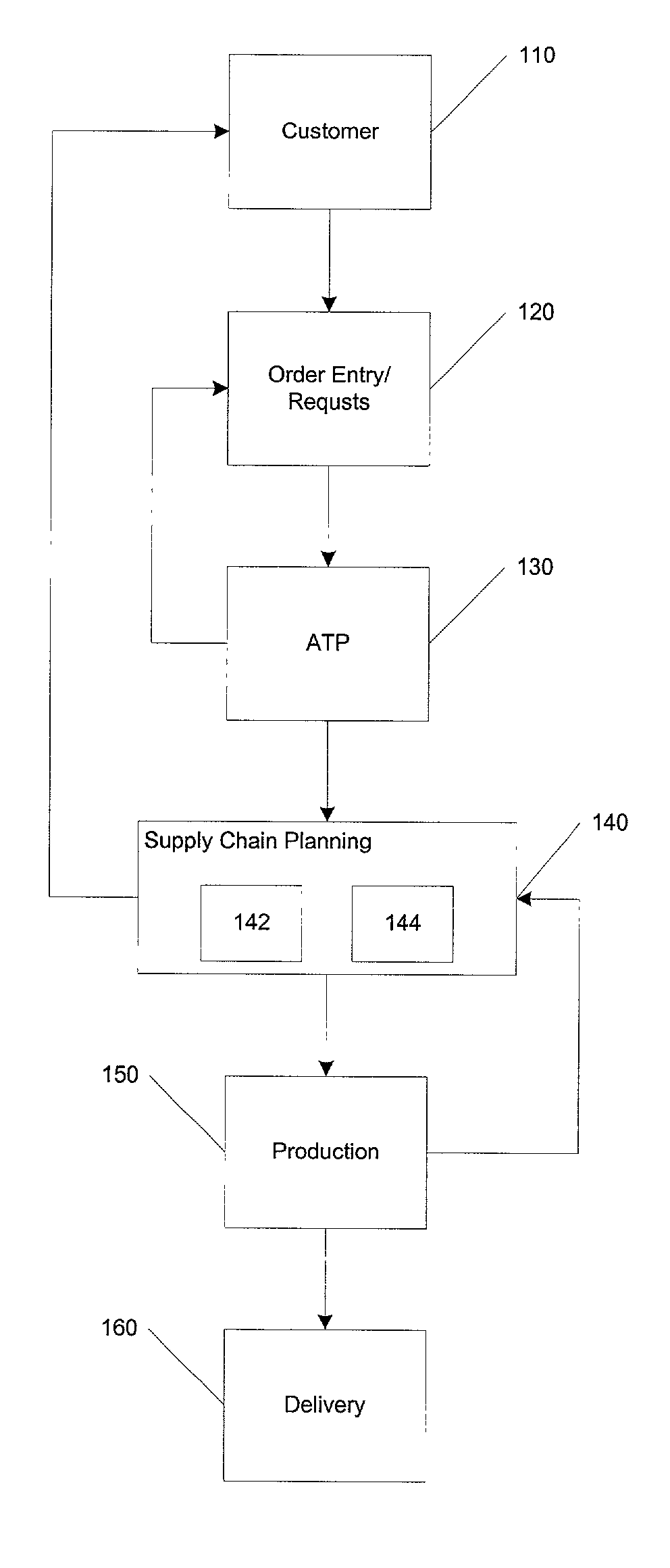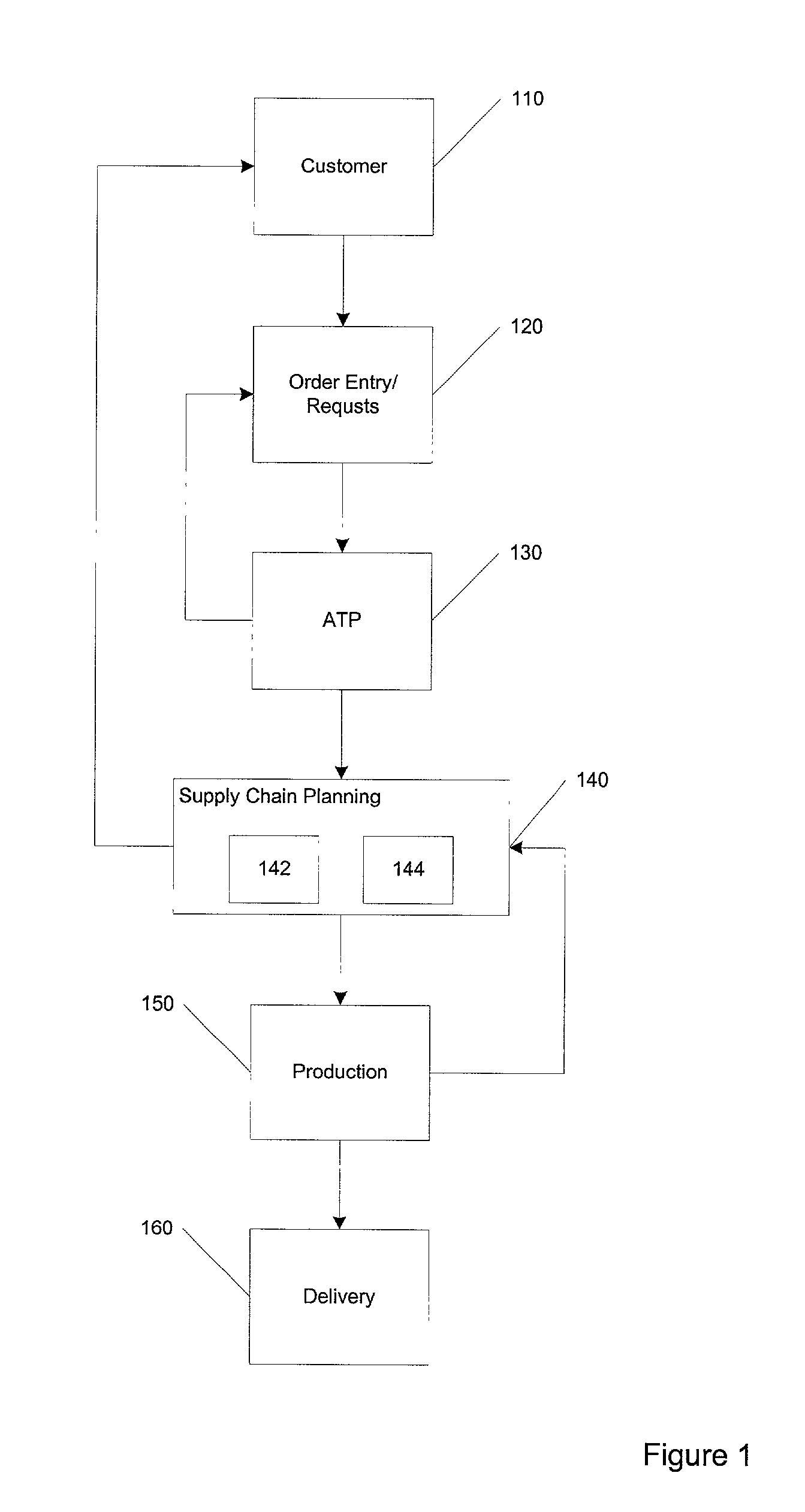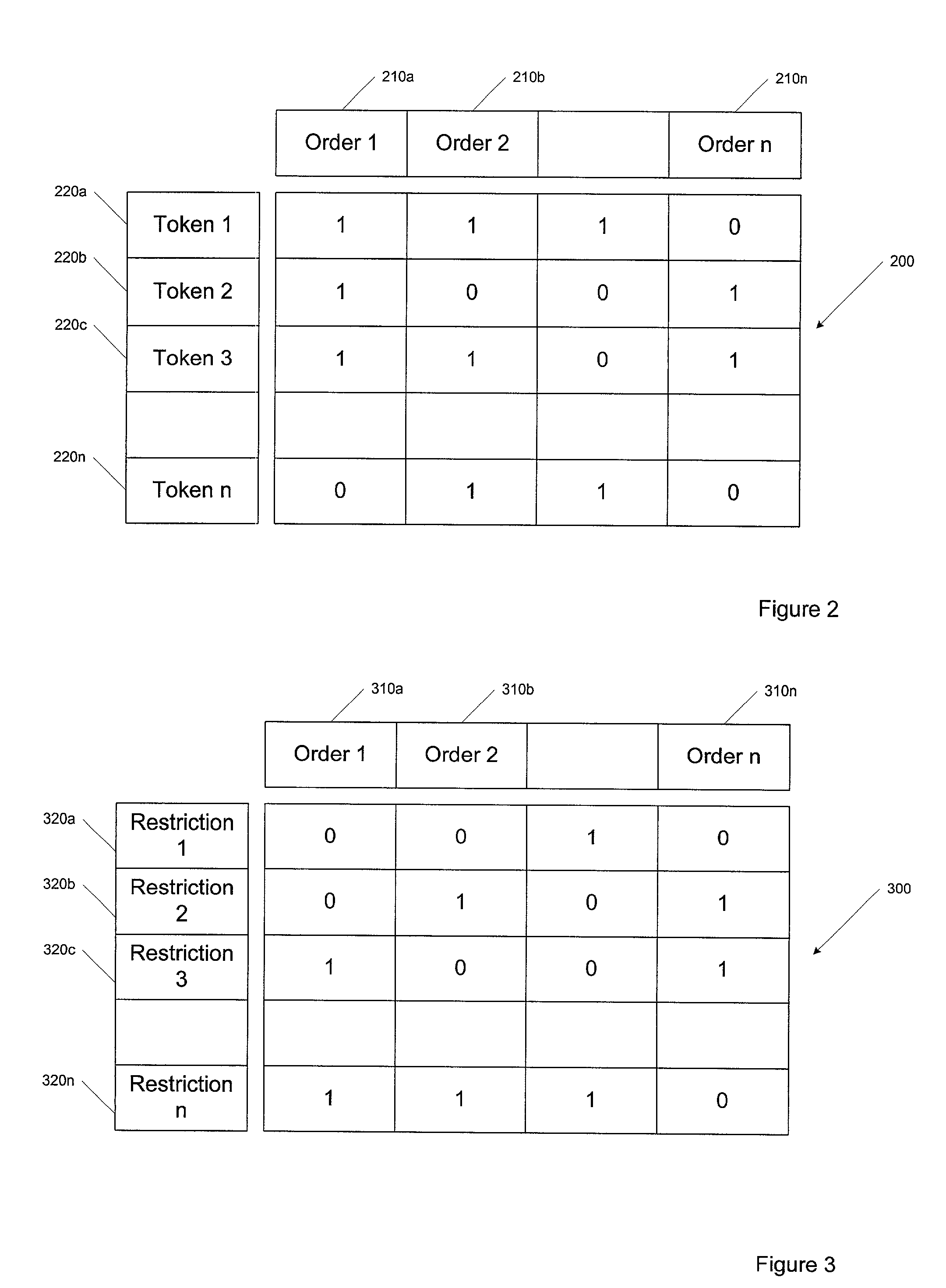Matrix methods and systems for supply chain management
a technology of supply chain management and matrix methods, applied in the direction of electric programme control, programme total factory control, instruments, etc., can solve the problems of shortage of raw materials by suppliers, complex product lines, and increased customer demands
Inactive Publication Date: 2002-01-17
SAP AG
View PDF9 Cites 33 Cited by
- Summary
- Abstract
- Description
- Claims
- Application Information
AI Technical Summary
Benefits of technology
[0028] FIG. 2 illustrates an order matrix consistent with an embodiment of the present invention. As shown in FIG. 2, a set of orders may be represented in matrix format in an order matrix 200. Each column 210a-210n represents an order. Each row 220a-220n represents a token. For example, the token of row 220a may represent the token (color=red). To denote that an order, as represented by a column 210, contains a token, a "1" is placed in the appropriate row of the column. If an order does not contain a token, a "0" is placed in the appropriate row of the column. The storage of orders in an order matrix allows the implementation of matrix algorithms that operate on one or more orders simultaneously. It also facilitates compact storage of all orders, in matrices or as a series of orders represented by bit vectors. In addition, additions to the order matrix are simplified because additional orders are represented by simply adding a column to the end of the matrix and because additional tokens can be added to the matrix by the addition of a row. The matrix can be stored through conventional data structures or can be stored in an object-oriented fashion.Rescheduling
[0033] FIG. 4 illustrates a production restriction matrix in an exemplary embodiment of the present invention. Production restriction matrix 400 comprises columns 410a-410n representing time periods, such as days, shifts, or any appropriate measure. Rows 420a-420n comprise restriction vectors and correspond to the restrictions 320a-320n of order restriction matrix 300. Within each cell of production restriction matrix 400, a value is placed indicating the number of units that are free for production for that restriction 420 in that time period 410. The restrictions for each restriction vector 420 are evaluated to see if any time delay needs to be added to the PRM 400. For instance, restriction 1 may require a one-day delay after restriction 5. If so, the vector is time shifted the appropriate delay. A second vector, an evaluation bit vector 430a-430n, is introduced under each restriction vector 420 in the PRM 400 with the evaluation bit vector's entries being designated a "1" if the restriction vector entry is "1" or greater or a "0" if the restriction vector entry is a "0". Once again, the use of bit vectors facilitates the rapid calculation and evaluation which this invention provides. Each order is checked against a derivative of the restriction table to determine available dates of production.
[0048] Because of the rapid execution of BOM explosion process 900 due to its logical evaluation of bit arrays, the process 900 may be re-executed as orders change, new orders are added, effectivity dates change, or selection condition change without requiring downtime or a loss of production while waiting for complex processing of data as in the prior art.
Problems solved by technology
At the same time, customers have become more demanding and frequently demand an accurate promised delivery date of an ordered product.
Many manufacturers have complex product lines that comprise dozens of products with each product line requiring thousands of material components.
Examples of such changes include a shortage of raw materials by suppliers, strikes, accidents or natural disasters.
With the sheer volume of configuration and customer order information, such databases are slow and unwieldy to update.
The typical automobile manufacturer may handle, for example, up to 14 million orders over a typical year, with thousands of characteristic values, such as interior and exterior color, resulting in a large variance of configurations.
Consequently, the order database must be large, and the writing and reading of such a large amount of information consumes a lot of run time and may require days to update.
If updates are performed in real time, the system runs the risk of inaccurate supple levels or estimated delivery dates.
Method used
the structure of the environmentally friendly knitted fabric provided by the present invention; figure 2 Flow chart of the yarn wrapping machine for environmentally friendly knitted fabrics and storage devices; image 3 Is the parameter map of the yarn covering machine
View moreImage
Smart Image Click on the blue labels to locate them in the text.
Smart ImageViewing Examples
Examples
Experimental program
Comparison scheme
Effect test
Embodiment Construction
, with each claim standing on its own as a separate preferred embodiment of the invention.
the structure of the environmentally friendly knitted fabric provided by the present invention; figure 2 Flow chart of the yarn wrapping machine for environmentally friendly knitted fabrics and storage devices; image 3 Is the parameter map of the yarn covering machine
Login to View More PUM
 Login to View More
Login to View More Abstract
A system and method of receiving orders, placing orders in an order matrix, determining potential production periods for an order, rescheduling orders, and generating a bill of materials. The method receives an order having one or more tokens out of a set of possible tokens. Each token is a combination of a characteristic and a value of the characteristic. The orders are placed in an order matrix. An order restriction matrix for the orders is generated based on certain selection conditions. The method then examines the restrictions that apply to the order and derives an order derived production restriction matrix for the order, which is evaluated to determine possible production periods for the order. The order matrix may also be used to generate a bill of materials.
Description
[0001] This application claims priority benefits based on U.S. Provisional Application 60 / 113,693, filed Mar. 31, 2000, the technical disclosure of which is incorporated herein by reference.[0002] This invention relates generally to methods and systems for supply chain management and, more particularly, to methods and systems for supply chain management using bit storage and calculations.[0003] In supply chain management, one goal is to have real time reaction up and down the supply chain. For example, many industries have moved to just-in-time models to supply parts to assembly line positions and warehouse inventories. Just-in-time supply models are cost efficient because they keep inventory low and allow quick reaction by the manufacturers to configuration changes. These same manufacturers, however, must constantly adjust the supply chain to ensure that no valuable production time is lost because an assembly line runs out of a necessary part. At the same time, customers have becom...
Claims
the structure of the environmentally friendly knitted fabric provided by the present invention; figure 2 Flow chart of the yarn wrapping machine for environmentally friendly knitted fabrics and storage devices; image 3 Is the parameter map of the yarn covering machine
Login to View More Application Information
Patent Timeline
 Login to View More
Login to View More IPC IPC(8): G05B19/418G06Q10/00
CPCG06Q10/06G06Q10/087G06Q10/0875
Inventor CLEMENS, ACHIMKERN, THOMAS
Owner SAP AG
Features
- R&D
- Intellectual Property
- Life Sciences
- Materials
- Tech Scout
Why Patsnap Eureka
- Unparalleled Data Quality
- Higher Quality Content
- 60% Fewer Hallucinations
Social media
Patsnap Eureka Blog
Learn More Browse by: Latest US Patents, China's latest patents, Technical Efficacy Thesaurus, Application Domain, Technology Topic, Popular Technical Reports.
© 2025 PatSnap. All rights reserved.Legal|Privacy policy|Modern Slavery Act Transparency Statement|Sitemap|About US| Contact US: help@patsnap.com



